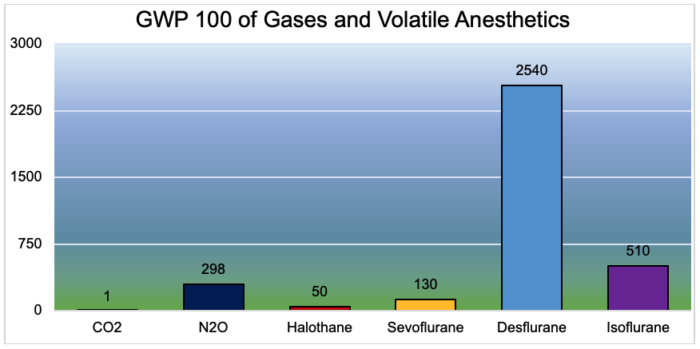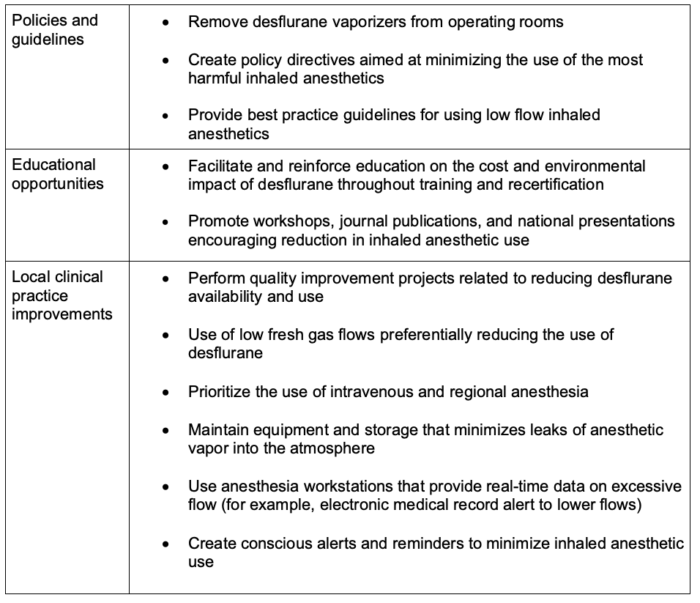Copy link
Environmental Impact of Desflurane
Last updated: 05/01/2024
Key Points
- Among the volatile anesthetics, desflurane is the most potent greenhouse gas and contributes to global warming throughout its life cycle.
- Leadership, education, and routine practice strategies can reduce the harmful environmental impact of desflurane.
Environmental Impact of Desflurane
- Volatile anesthetics contribute to global warming by the same mechanism as other greenhouse gases (e.g., carbon dioxide, methane, and nitrous oxide). Desflurane is a potent volatile anesthetic that quickly became popular due to its low blood solubility and resultant capacity to allow for rapid titration of anesthetic depth. Recent research has exposed the harmful environmental impact of volatile anesthetics, with desflurane being the worst offender.1-3
- Global warming potential (GWP) is a metric used to quantify greenhouse gas emissions. It specifically refers to the ability of a gas molecule to trap infrared light in the atmosphere and is typically expressed as the warming effect over a 100-year timescale. A higher value of GWP indicates a greater reflection of radiative energy.
- Among the volatile anesthetics, desflurane has the highest GWP100 at 2540. The calculated GWP of desflurane is about 20 times higher than sevoflurane and 5 times higher than isoflurane.2 Most of the environmental impact from desflurane occurs from its direct release into the atmosphere. Additionally, desflurane’s life cycle analysis shows a significantly greater impact from its manufacture and distribution than any other volatile anesthetic.3

Figure 1. GWP100 of common anesthesia gases and volatile anesthetics
- For years, data has shown how the healthcare system contributes to climate change. Healthcare in the United States emits enough greenhouse gases to be ranked as the 13th most pollutant country in the world.4 The American Society of Anesthesiologists (ASA) published guidelines on avoiding inhaled anesthetics with high climate impacts and prioritizing regional and intravenous anesthesia techniques.
- The cost of desflurane, when compared to other inhaled anesthetics, is consistently higher across the nation. Many quality improvement projects are institutions across the country have shown large reductions in cost. For example, in some institutions, $1,000 per day, or $30,000 to $100,000 per year, was saved when less desflurane was used or eliminated from practice.5,6
Strategies to Mitigate the Environmental Effects of Desflurane
Multiple strategies can be used to mitigate the environmental impact of desflurane (Table 1). Currently, multiple institutions across the country have removed the desflurane vaporizer from the anesthesia machines.
- Educating providers on the cost and environmental impact of anesthetic gases is critical. The ASA Task Force on Environmental Sustainability Committee on Equipment and Facilities has published guidelines and education materials for anesthesiology providers. Anesthesia providers can apply more environmentally friendly techniques, such as low-flow anesthesia, total intravenous anesthesia (TIVA), and regional anesthesia techniques when appropriate.7
- The most important aspects of sustainable practice are creating policy directives aimed at mitigating the most impactful greenhouse gases at a national level and adhering to best practice guidelines from national societies.

Table 1. Summary of strategies to mitigate the environmental effects of desflurane
References
- Meyer MJ. Desflurane should des-appear: Global and financial rationale. Anesth Analg. 2020;131(4):1317-22. PubMed
- Ryan SM, Nielsen CJ. Global warming potential of inhaled anesthetics: Application to clinical use. Anesth Analg. 2010;111(1):92-8. PubMed
- Sherman J, Le C, Lamers V, Eckelman M. Life cycle greenhouse gas emissions of anesthetic drugs. Anesth Analg. 2012;114(5):1086-90. PubMed
- Eckelman MJ, Sherman J. Environmental impacts of the U.S. health care system and effects on public health. PLoS One. 2016;11(6):e0157014. PubMed
- Miller SA, Aschenbrenner CA, Traunero JR, et al. $1.8 Million and counting: how volatile agent education has decreased our spending $1000 per day. J Clin Anesth. 2016; 35:253-8. PubMed
- Schwotzer E, Sheehan K. Healthcare without Harm. Healing patients and planet with 1 cost-saving anesthesia adjustment. Health Care Without Harm newsletter. Published February 18th, 2020. Accessed May 1, 2024. Link
- Zoghbi V, Lin C, Fahrenbach V. Rethinking desflurane. CSA Task Force on Environmental Sustainability. California Society of Anesthesiologist. Published May 16th, 2022. Accessed May 1, 2024. Link
Copyright Information

This work is licensed under a Creative Commons Attribution-NonCommercial-NoDerivatives 4.0 International License.